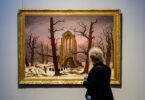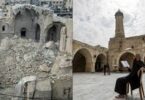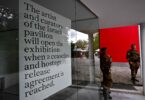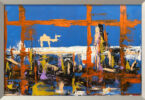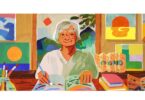DUBAI (Arabnews): Highlights from the auction house’s recent 20th Century Art/Middle East sale
Hamed Abdalla
‘Ville Arab’
Cairo-born Abdalla was the son of peasants and a self-taught artist whose work drew from Egyptian folk art and his own deep connection to his homeland (despite leaving for Europe as an adult). His lack of formal artistic education enabled him to create with academic limitations and his work became an important component of modern Egyptian art. This painting is a fine example of both his aesthetic and thematic styles, showing a traditional house and its kitchen, with a farmer standing at the open door — embodying the rustic simplicity that Abdalla so admired, and the hospitality that is so important in Arab culture. The gallery notes: “A variety of pale blue and white tones dominate the composition, in accordance with Abdalla’s belief that these are the colors characterizing the Egyptian palette, due to the dazzling sunlight that softens their intensity.”
Fahrelnissa Zeid
‘The Blue Tree’
Zeid was a significant pioneer in modernist art. She was one of the first women to study fine arts in Turkey and, according to Sotheby’s, “her works were often said to feature intricate blends of Islamic and Byzantine patterns infused with Western modernist and abstractionist inspirations.” She experimented with numerous techniques and styles throughout her career, during which she worked in Istanbul, Paris, Berlin, Baghdad and London. This painting was completed in 1943, when Zeid was still in the Turkish capital, and was part of her first solo exhibition, which also featured several other paintings in which trees were the focus. “The Blue Tree” — inspired by a tree from Zeid’s own garden, is, Sotheby’s says, “indicative of the artist’s gradual transition towards abstraction, the branches made of undulated lines roaming the canvas, enlightened by a bluish glow conferring a mystical atmosphere to the painting.”
Munira Al-Kazi
‘Untitled’
The India-born Saudi-Kuwaiti Al-Kazi is one of the GCC’s most significant female artists. Throughout her career, she demonstrated a willingness to experiment with form and materials. She studied at London’s Central School of Art and Design, where she specialized in printmaking, and this work from the early Sixties reflects this. “The work is at once painted, cut, creased, and etched,” the auction catalogue states. “It comprises her notable geometric motifs and a button added to the center in a unique manner that is inherent to the artist’s style.”
Farid Belkahia
‘Untitled’ (1981)
Belkahia, who died in 2014, was hugely important to Morocco’s modern-art scene, founding the Casablanca Group with Mohammed Melehi and Mohamed Chebaa. He focused much of his life on taking Moroccan folk traditions and “updating” them in his art, in which the principles of Arabic calligraphy were a guiding factor. This is a stretched leather painting that incorporates traditional Berber motifs. The artist gave up on oil paints and canvas in the Sixties, instead creating his own surfaces from animal skin and using pigments he created from minerals and plants. “On this painting, the undulating shapes seems to flow through the vellum, spreading a vital energy of primitive nature, almost bestial,” Sotheby’s says. “Through these dynamic artworks, Belkahia appeals to the fundamental sensory function of skin, conveying both sensuality and mysticism.”
Salah Yousri
‘Le Temps des Labours’
This atmospheric painting is a prime example of why this Egyptian artist is so lauded. Like so many of his peers around the Arab world, Yousri was inspired by the traditions and iconography of his homeland, and wanted to celebrate his country’s working-class people. “Yousri emphasises his country’s ancestral artistic heritage while subtly demonstrating his political engagement, in what can be interpreted as a call for social reform,” the auction brochure states.
Gazbia Sirry
‘Palm Tree’
The researcher and writer Fatenn Mostafa-Kanafani describes Sirry as “one of the most influential figures of 20th-century modern Arab art and a leading figure in the Egyptian modernist movement. If Mahmoud Saïd is considered the father figure of Egyptian modernism, Sirry is the mother.” She continues: “Unwavering in her commitment to the nationalist discourse and gender politics, Sirry dedicated the first part of her career to drawing attention to the socio-political conditions of the Egyptian working class. She pioneered a movement of eclectic social realism with a punch in the process.”
Safwan Dahoul
‘Untitled’ (From the Rêve Series)
This Syrian artist is, Sotheby’s says, “known for his unique and innovative techniques of figuration, which — throughout his three-decades-long career — (he used) to describe the fluctuations in feelings and psyche within the Arab world.” Influenced by the Cubist movement in the West and by Assyrian and ancient Egyptian art, Dahoul formulated a singular style “distinguishable by a melancholic and monochromatic aura.” That style was most perfectly realized in his “Dream” series, to which this piece belongs. “Both defensive yet surrendered, the painting suggests a form of weariness slowly giving place to serenity,” the catalogue states.
Hussein Bikar
‘Untitled’ (1995)
Legend has it that the Alexandria-born Bikar was a child prodigy — not just a talented artist, but also a poet and musician who was teaching the lute to others by the age of nine. Sotheby’s auction catalogue says of his art that, “while paying homage to the miniature paintings of the earlier Islamic period, Bikar had the keen ability to articulate form in an impeccable relation to geometry spacing his compositions in a logical and linear manner … Bikar flattens his overlaying patterns to demarcate an imaginative sense of space and perspective.”

